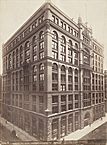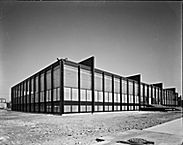| Entries |
| A |
|
Architecture
|

|
However, the distinctive and reknowned story of Chicago architecture seldom begins with Boyington and Van Osdel, because their work is viewed as derivative and utilitarian rather than artistic and groundbreaking. The 1871 fire and Chicago's subsequent meteoric growth drew architects with vision and daring.

|
In the mid-twentieth century, a modern style dominated by sheaths of metal and glass, championed by Ludwig Mies van der Rohe, characterized a “Second Chicago School.” In the closing decades of the twentieth century a postmodern reaction to the simplicity of the Second Chicago School emerged in the work of architects like Helmut Jahn.
The Electronic Encyclopedia of Chicago © 2005 Chicago Historical Society.
The Encyclopedia of Chicago © 2004 The Newberry Library. All Rights Reserved. Portions are copyrighted by other institutions and individuals. Additional information on copyright and permissions.
The Encyclopedia of Chicago © 2004 The Newberry Library. All Rights Reserved. Portions are copyrighted by other institutions and individuals. Additional information on copyright and permissions.